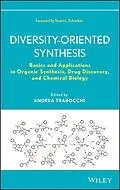Discover an enhanced synthetic approach to developing and
screening chemical compound libraries
Diversity-oriented synthesis is a new paradigm for developing
large collections of structurally diverse small molecules as probes
to investigate biological pathways. This book presents the most
effective methods in diversity-oriented synthesis for creating
small molecule collections. It offers tested and proven strategies
for developing diversity-oriented synthetic libraries and screening
methods for identifying ligands. Lastly, it explores some promising
new applications based on diversity-oriented synthesis that have
the potential to dramatically advance studies in drug discovery and
chemical biology.
Diversity-Oriented Synthesis begins with an introductory
chapter that explores the basics, including a discussion of the
relationship between diversity-oriented synthesis and classic
combinatorial chemistry. Divided into four parts, the book:
* Offers key chemical methods for the generation of small
molecules using diversity-oriented principles, including
peptidomimetics and macrocycles
* Expands on the concept of diversity-oriented synthesis by
describing chemical libraries
* Provides modern approaches to screening diversity-oriented
synthetic libraries, including high-throughput and high-content
screening, small molecule microarrays, and smart screening
assays
* Presents the applications of diversity-oriented synthetic
libraries and small molecules in drug discovery and chemical
biology, reporting the results of key studies and forecasting the
role of diversity-oriented synthesis in future biomedical
research
This book has been written and edited by leading international
experts in organic synthesis and its applications. Their
contributions are based on a thorough review of the current
literature as well as their own firsthand experience developing
synthetic methods and applications.
Clearly written and extensively referenced,
Diversity-Oriented Synthesis introduces novices to this
highly promising field of research and serves as a springboard for
experts to advance their own research studies and develop new
applications.
Autorentext
ANDREA TRABOCCHI, PhD, is Assistant Professor of Organic
Chemistry at the University of Florence. Dr. Trabocchi leads
research in diversity-oriented synthesis, peptidomimetic
chem-istry, chemical genetics, and conformational analysis.
Zusammenfassung
Discover an enhanced synthetic approach to developing and screening chemical compound libraries
Diversity-oriented synthesis is a new paradigm for developing large collections of structurally diverse small molecules as probes to investigate biological pathways. This book presents the most effective methods in diversity-oriented synthesis for creating small molecule collections. It offers tested and proven strategies for developing diversity-oriented synthetic libraries and screening methods for identifying ligands. Lastly, it explores some promising new applications based on diversity-oriented synthesis that have the potential to dramatically advance studies in drug discovery and chemical biology.
Diversity-Oriented Synthesis begins with an introductory chapter that explores the basics, including a discussion of the relationship between diversity-oriented synthesis and classic combinatorial chemistry. Divided into four parts, the book:
- Offers key chemical methods for the generation of small molecules using diversity-oriented principles, including peptidomimetics and macrocycles
- Expands on the concept of diversity-oriented synthesis by describing chemical libraries
- Provides modern approaches to screening diversity-oriented synthetic libraries, including high-throughput and high-content screening, small molecule microarrays, and smart screening assays
- Presents the applications of diversity-oriented synthetic libraries and small molecules in drug discovery and chemical biology, reporting the results of key studies and forecasting the role of diversity-oriented synthesis in future biomedical research
This book has been written and edited by leading international experts in organic synthesis and its applications. Their contributions are based on a thorough review of the current literature as well as their own firsthand experience developing synthetic methods and applications.
Clearly written and extensively referenced, Diversity-Oriented Synthesis introduces novices to this highly promising field of research and serves as a springboard for experts to advance their own research studies and develop new applications.
Inhalt
CONTRIBUTORS xv
FOREWORD xix
PREFACE xxi
ABBREVIATIONS xxv
1 The Basics of Diversity-Oriented Synthesis 1
Kieron M. G. O'Connell, Warren R. J. D. Galloway, and David R. Spring
1.1 Introduction, 1
1.2 What Is Diversity-Oriented Synthesis?, 1
1.3 Small Molecules and Biology, 2
1.4 Comparing DOS, TOS, and Combinatorial Chemistry: Focused Library Synthesis, 4
1.5 Molecular Diversity, 5
1.6 Molecular Diversity and Chemical Space, 8
1.7 Synthetic Strategies for Creating Molecular Diversity, 8
1.8 Reagent-Based Approaches to Diversity Generation, 11
1.9 Substrate-Based Approach to Skeletal Diversity Generation, 19
1.10 Other Build/Couple/Pair Examples, 19
1.11 Concluding Remarks, 24
PART I CHEMICAL METHODOLOGY IN DIVERSITY-ORIENTED SYNTHESIS
2 Strategic Applications of Multicomponent Reactions in Diversity-Oriented Synthesis 29
John M. Knapp, Mark J. Kurth, Jared T. Shaw, and Ashkaan Younai
2.1 Introduction, 29
2.2 MCR Products for HTS, 31
2.3 MCRs as Starting Points for DOS, 39
2.4 Conclusions, 55
3 Cycloaddition Reactions in Diversity-Oriented Synthesis 59
Giovanni Muncipinto
3.1 Introduction, 59
3.2 [4+2] Cycloaddition Reactions, 60
3.3 1,3-Dipolar Cycloaddition Reactions, 70
3.4 Miscellaneous Cycloadditions, 83
3.5 Conclusions, 91
4 Phosphine Organocatalysis as a Platform for Diversity-Oriented Synthesis 97
Zhiming Wang and Ohyun Kwon
4.1 Introduction, 97
4.2 DOS Using Phosphine Organocatalysis, 100
4.3 Skeletal Diversity Based on a Phosphine Catalysis/Combinatorial Scaffolding Strategy, 116
4.4 A DOS Library Based on Phosphine Organocatalysis: Biological Screening, Analog Synthesis, and StructureActivity Relationship Analysis, 121
4.5 Conclusions, 129
5 Domino Reactions in Library Synthesis 135
Matthew G. LaPorte, John R. Goodell, Sammi Tsegay, and Peter Wipf
5.1 Introduction, 135
5.2 Pericyclic Domino Reactions, 136
5.3 Anionic Domino Reactions, 150
5.4 Transition-Metal-Mediated Domino Reactions, 159
5.5 Radical Domino Reactions, 165
5.6 Conclusions, 174
6 Diversity-Oriented Synthesis of Amino AcidDerived Scaffolds and Peptidomimetics: A Perspective 177
Andrea Trabocchi
6.1 Introduction, 177
6.2 Definition and Classification of Peptidomimetics, 179
6.3 Early Combinatorial Approaches to Peptidomimetic Scaffolds, 180
6.4 Amino AcidDerived Scaffolds, 183
6.5 Macrocyclic Peptidomimetic Scaffolds, 194
6.6 Conclusions, 197
7 Solid-Phase Synthesis Enabling Chemical Diversity 201
Nadezda Canka¡rova and Viktor Krch¡nak
7.1 Introduction, 201
7.2 Skeletal Diversity, 203
7.3 Stereochemical Diversity, 234
7.4 Appendage Diversity, 238
7.5 …
